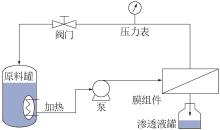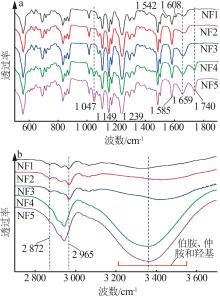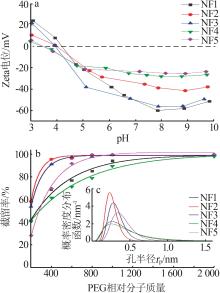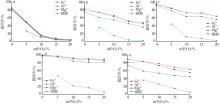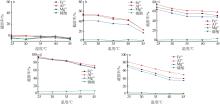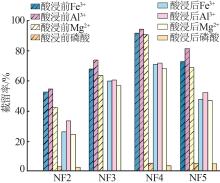Inorganic Chemicals Industry ›› 2023, Vol. 55 ›› Issue (12): 133-139.doi: 10.19964/j.issn.1006-4990.2023-0134
• Environment·Health·Safety • Previous Articles Next Articles
Experimental study on removing metal ions from phosphoric acid by nanofiltration membrane
TIAN Zhuangzhuang1,2( ), CHEN Jianjun1,2(
), CHEN Jianjun1,2( ), JIN Yang1,2, CHEN Ming1,2, LI Jun1,2, LIU Daijun1,2
), JIN Yang1,2, CHEN Ming1,2, LI Jun1,2, LIU Daijun1,2
- 1. School of Chemical Engineering,Sichuan University,Chengdu 610065,China
2. Engineering Research Center for Comprehensive Utilization and Cleaning Process of Phosphate Resource,Ministry of Education,Chengdu 610065,China
-
Received:2023-03-13Online:2023-12-10Published:2023-12-14 -
Contact:CHEN Jianjun E-mail:tianzhuangzhuang6@126.com;chenjianjun@scu.edu.cn
CLC Number:
Cite this article
TIAN Zhuangzhuang, CHEN Jianjun, JIN Yang, CHEN Ming, LI Jun, LIU Daijun. Experimental study on removing metal ions from phosphoric acid by nanofiltration membrane[J]. Inorganic Chemicals Industry, 2023, 55(12): 133-139.
share this article
Table 3
MWCO before and after acid stability testof nanofiltration membranes"
纳滤膜 型号 | MWCO (酸浸前/ 酸浸后) | 孔半径/nm (酸浸前/ 酸浸后) | 平均有效孔 半径μp/nm (酸浸前/酸浸后) | 几何标准差σp(酸浸前/ 酸浸后) |
|---|---|---|---|---|
| NF2 | 327/557 | 0.42/0.57 | 0.307/0.371 | 1.272/1.393 |
| NF3 | 385/1 095 | 0.46/0.82 | 0.311/0.471 | 1.356/1.576 |
| NF4 | 1 131/665 | 0.84/0.62 | 0.388/0.414 | 1.895/1.366 |
| NF5 | 600/2 194 | 0.59/1.21 | 0.385/0.749 | 1.402/1.481 |
| 1 |
GONZÁLEZ M P, SAUCEDO I, NAVARRO R, et al. Effect of phosphoric and hydrofluoric acid on the structure and permeation of a nanofiltration membrane[J]. Journal of Membrane Science, 2006, 281(1/2):177-185.
doi: 10.1016/j.memsci.2006.03.038 |
| 2 |
GONZÁLEZ M P, NAVARRO R, SAUCEDO I, et al. Purification of phosphoric acid solutions by reverse osmosis and nanofiltrati- on[J]. Desalination, 2002, 147(1/2/3):315-320.
doi: 10.1016/S0011-9164(02)00558-1 |
| 3 |
LEE K P, ZHENG Jumeng, BARGEMAN G, et al. pH stable thin film composite polyamine nanofiltration membranes by interfacial polymerisation[J]. Journal of Membrane Science, 2015, 478:75- 84.
doi: 10.1016/j.memsci.2014.12.045 |
| 4 |
SCHÜTTE T, NIEWERSCH C, WINTGENS T, et al. Phosphorus recovery from sewage sludge by nanofiltration in diafiltration mode[J]. Journal of Membrane Science, 2015, 480:74-82.
doi: 10.1016/j.memsci.2015.01.013 |
| 5 |
GUASTALLI A R, LABANDA J, LLORENS J. Separation of phosphoric acid from an industrial rinsing water by means of nanofiltration[J]. Desalination, 2009, 243(1/2/3):218-228.
doi: 10.1016/j.desal.2008.04.024 |
| 6 |
XU Shanshan, HE Rongrong, DONG Chenjun, et al. Acid stable layer-by-layer nanofiltration membranes for phosphoric acid purification[J]. Journal of Membrane Science, 2022, 644:120090.
doi: 10.1016/j.memsci.2021.120090 |
| 7 |
REMMEN K, MÜLLER B, KÖSER J, et al. Phosphorus recovery in an acidic environment using layer-by-layer modified membran-es[J]. Journal of Membrane Science, 2019, 582:254-263.
doi: 10.1016/j.memsci.2019.03.023 |
| 8 | REMMEN K, MÜLLER B, KÖSER J, et al. Assessment of layer-by-layer modified nanofiltration membrane stability in phosphoric acid[J]. Membranes, 2020, 10(4). Doi:10.3390/membranes 10040061 . |
| 9 | 冯超群, 杨峰, 陈天缘, 等. 分光光度法测定聚乙二醇水溶液浓度[J]. 科技资讯, 2013, 11(5):126-127. |
| FENG Chaoqun, YANG Feng, CHEN Tianyuan, et al. Determination of polyethylene glycol content by spectrophotometric[J]. Science & Technology Information, 2013, 11(5):126-127. | |
| 10 |
ZIMUDZI T J, FELDMAN K E, STURNFIELD J F, et al. Quantifying carboxylic acid concentration in model polyamide desalination membranes via fourier transform infrared spectroscopy[J]. Macromolecules, 2018, 51(17):6623-6629.
doi: 10.1021/acs.macromol.8b01194 |
| 11 | ISMAIL N Q, AZMI N A, SHOPARWE N F, et al. Characterization effect of polysulfone membranes with different molecular weight of polyethylene glycol additives[J]. IOP Conference Series:Earth and Environmental Science, 2022, 1102(1): 012085. |
| 12 |
BAROÑA G N B, LIM J, JUNG B. High performance thin film composite polyamide reverse osmosis membrane prepared via m-phenylenediamine and 2,2′-benzidinedisulfonic acid[J]. Desalination, 2012, 291:69-77.
doi: 10.1016/j.desal.2012.02.001 |
| 13 |
CAO D X, LEIFERT D, BRUS V V, et al. The importance of sulfonate to the self-doping mechanism of the water-soluble conjugated polyelectrolyte PCPDTBT-SO3K[J]. Materials Chemistry Frontiers, 2020, 4(12):3556-3566.
doi: 10.1039/D0QM00073F |
| 14 |
LIU Lifen, CAI Zhibin, SHEN Jiangnan, et al. Fabrication and characterization of a novel poly(amide-urethane@imide) TFC reverse osmosis membrane with chlorine-tolerant property[J]. Journal of Membrane Science, 2014, 469:397-409.
doi: 10.1016/j.memsci.2014.06.029 |
| 15 | LIU Lifen, GU Xingling, QI Saren, et al. Modification of polyamide-urethane(PAUt) thin film composite membrane for improving the reverse osmosis performance[J]. Polymers, 2018, 10(4). Doi:10.3390/polym10040346 . |
| 16 | WANG Jingyu, REN Yuling, ZHANG Huiru, et al. Targeted modification of polyamide nanofiltration membrane for efficient sepa-ration of monosaccharides and monovalent salt[J]. Journal of Me-mbrane Science, 2021,628:119250. |
| 17 |
GAO Jie, WANG K, CHUNG T. Design of nanofiltration(NF) hollow fiber membranes made from functionalized bore fluids containing polyethyleneimine(PEI) for heavy metal removal[J]. Journal of Membrane Science, 2020, 603:118022.
doi: 10.1016/j.memsci.2020.118022 |
| 18 |
GU Kaifeng, PANG Sichen, YANG Binbin, et al. Polyethyleneimine/4,4′-Bis(chloromethyl)-1,1′-biphenyl nanofiltration membrane for metal ions removal in acid wastewater[J]. Journal of Membrane Science, 2020, 614:118497.
doi: 10.1016/j.memsci.2020.118497 |
| 19 |
BARGEMAN G, WESTERINK J B, GUERRA MIGUEZ O, et al. The effect of NaCl and glucose concentration on retentions for nanofiltration membranes processing concentrated solutions[J]. Separation and Purification Technology, 2014, 134:46-57.
doi: 10.1016/j.seppur.2014.07.025 |
| 20 |
ROY Y, WARSINGER D M, LIENHARD J H. Effect of temperature on ion transport in nanofiltration membranes:Diffusion,convection and electromigration[J]. Desalination, 2017, 420:241- 257.
doi: 10.1016/j.desal.2017.07.020 |
| [1] | ZHANG Li, ZHANG Dan, PAN Hongyan, DONG Yonggang, LI Wenfei, QIN Hong. Study on preparation of low ash activated carbon by phosphoric acid method [J]. Inorganic Chemicals Industry, 2024, 56(2): 95-103. |
| [2] | JIN Shengshi, LIU Kaijie, LIU Qiuwen, ZHANG Yibo, YANG Xiangguang. Study on catalytic performance of phosphoric acid modified CeO2 nanorod supported Pt catalyst for propane combustion [J]. Inorganic Chemicals Industry, 2024, 56(1): 141-148. |
| [3] | ZHANG Ying, LI Jun, JIN Yang, HUANG Meiying. Study on pyrolysis regeneration of activated carbon for Tributyl phosphate decolorization [J]. Inorganic Chemicals Industry, 2024, 56(1): 59-66. |
| [4] | FU Yu, DENG Mi, HUANG Donggen, WAN Jinbao. Research progress of lithium extraction technology from salt lake brine [J]. Inorganic Chemicals Industry, 2023, 55(9): 9-16. |
| [5] | LI Jiaqiang, LI Jun, JIN Yang, CHEN Ming. A gas chromatographic analysis method for acetic acid content in phosphoric acid and acetic acid mixed system [J]. Inorganic Chemicals Industry, 2023, 55(5): 115-120. |
| [6] | ZHOU Qinglie, WANG Baoqi, ZHANG Zhiye, ZHANG Yinghu, WANG Jian, YANG Lin. Development of new process of removing metal cations from wet-process phosphoric acid by extraction [J]. Inorganic Chemicals Industry, 2023, 55(3): 84-91. |
| [7] | HE Fuduo, YUAN Yifan, ZHOU Xiaohou, XU Lu, SUN Chongqing, WANG Xinlong, XU Dehua. Preparation of monoammonium phosphate containing amino acid from waste feathers by in situ acid hydrolysis of wet process of phosphoric acid [J]. Inorganic Chemicals Industry, 2023, 55(10): 100-105. |
| [8] | LIN Yuqing,ZHANG Yiren,QIU Yulong,ZHANG Jiayu,YU Jianguo. Progress and prospect of membrane technology in lithium extraction from salt lake brine [J]. Inorganic Chemicals Industry, 2023, 55(1): 33-45. |
| [9] | HE Lei,ZHU Ganyu,ZHENG Guangming,WU Wenfen,ZhANG Jianbo,LI Fang,LI Huiquan,CHEN Wen. Study on crystallization process and mechanism of phosphogypsum in wet process phosphoric acid system [J]. Inorganic Chemicals Industry, 2022, 54(7): 110-116. |
| [10] | FU Ziqi, ZHANG Cheng, SHENG Yong, JI Lijun. Study on preparation of phosphoric acid by leaching fluoride residue from wet-process phosphoric acid with organic solvents [J]. Inorganic Chemicals Industry, 2022, 54(7): 129-134. |
| [11] | ZHENG Hanxiao,LÜ Li,TANG Shengwei,HE Yanjun,ZHANG Tao. Leaching behavior of phosphate ore in phosphoric acid [J]. Inorganic Chemicals Industry, 2022, 54(10): 96-101. |
| [12] | WANG Xianshun,DOU Yan,WANG Qi,CUI Peng,MA Jun,SHEN Hao,ZHENG Zhiyin,LIU Rong. Identification of colored substances in wet process phosphoric acid leaching slurry [J]. Inorganic Chemicals Industry, 2022, 54(1): 86-90. |
| [13] | Su Shu,Xu Dehua,Li Chaorong,Yang Xiushan,Wang Xinlong,Zhang Zhiye. Study on defluorination of phosphoric acid by nitric acid process [J]. Inorganic Chemicals Industry, 2021, 53(9): 24-29. |
| [14] | Zhang Shaojie,Tang Shengwei,Wang Yang,Zheng Dongyue,Zhong Benhe,Chen Yanxiao. Preliminary study on scrubbing and stripping operation of the extracted organic phase in wet phosphoric acid process by hydrochloric acid route [J]. Inorganic Chemicals Industry, 2021, 53(8): 36-43. |
| [15] | Ran Ruiquan,Jin Yang,Liu Hui,Li Jun,Zhang Jun,Chen Ming. Research progress purification of solvent extraction of wet-process phosphoric acid by hydrochloric acid route [J]. Inorganic Chemicals Industry, 2021, 53(7): 18-22. |
| Viewed | ||||||
|
Full text |
|
|||||
|
Abstract |
|
|||||
|
||
